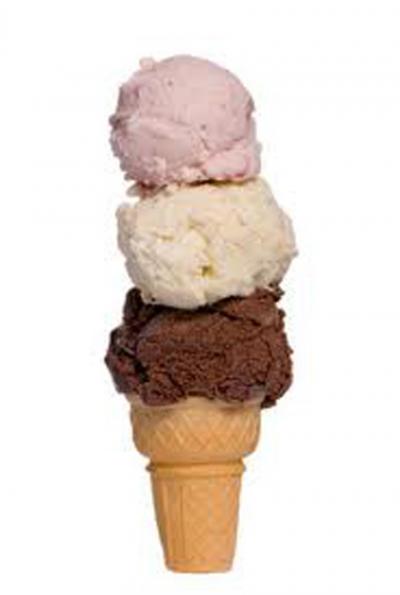
A Short History of Ice Cream

Hi, my name is Alivia Jones. I’m 11 years old. I wanted to write an article to send in to the Loop which would be for kids, by another kid. This kid in particular is home schooled and really hopes she knows something about writing articles-otherwise, she’ll be in a bit of a mess!
Some historians think that the Asians and Romans and other ancient cultures had ice cream. It’s not the same as real, dairy ice cream though-for example, Nero had slaves run to the mountains, gather snow, run back before it melted, and he’d eat it with fresh fruit on top. I don’t think this qualifies as ice cream, so we’ll start our history lesson with the first real proof of ice cream, though it still wouldn’t be quite as thick and creamy as it is today.
In the 1600s, King Charles I hired a French chef (though there’s some debate as to whether he could have been Italian). The chef knew how to make ice cream, which he made for the King-who told him to keep it a royal secret. We’re not sure if the cook was bribed with large amounts of money or threatened with death if he broke the deal. Only the king was allowed to eat the delicacy until his death in 1649, when the cook divulged the recipe to the public.
Unfortunately for the butcher, the baker and the candle-stick maker, the truly ‘fit-for-a-king’ treat was still only for the rich, as it was expensive and time-consuming to make.
By the 1700s, ‘iced creams’ or ‘crème ice’ was widely known in both Europe and America. Several recipes are found in a 1700 French cookbook titled ‘L’Art de Faire des Glaces’, and in the developed colonies which would one day be the US, ice cream was also known. In 1777, the first newspaper ad and the first shop for ice cream appeared-the shop opened in New York City.
The presidents liked ice cream, too. George Washington paid nearly $200, a large amount of money then, for ice cream recipes and equipment in 1790. Thomas Jefferson had a special vanilla ice cream recipe, and was the first to serve it in the White House in 1802. James Madison served ice cream at his 2nd inaugural ball in 1813.
Ordinary people still couldn’t afford ice cream, as there was a huge amount of effort involved. You needed two large bowls, lots of ice and salt, and 40 whole minutes of shaking one bowl while stirring the other...imagine, you’d become a pro boxer doing that regularly!
But finally, the masses were given an opportunity to enjoy this frozen delight when Nancy Johnson patented her own invention of the first hand-crank ice cream maker in 1843. A lot of people don’t know this because she sold her rights to the product to William Young for $200. At least the machine was named the ‘Johnson Patent Ice-Cream Freezer’.
The hand crank worked fine for small uses, but nobody really thought of ice cream as an industry until 1851, when Jacob Fussell, a milk dealer, was looking for some way to keep a steady demand for the cream he sold. He did so by turning it into ice cream, and for that he could get twice the price of ordinary cream. He opened a factory in Baltimore which made use of icehouses and a larger version of Johnson’s machine. By the start of the Civil War he had more ice cream plants in New York, Washington, and Boston.
But-sigh-ice cream didn’t become popular and easy-to-get until the 1900s, when new inventions in refrigeration and electricity let production increase dramatically. For example, in 1899 five million gallons were produced in the US; in 1909, thirty million; in 1919, one hundred and fifty million!
Let’s get to what I’m sure you want to hear-how was the ice cream cone invented, and when? Well, there are two stories-one is fun, but not very likely to be the first use of the ice cream cone, and one is probably true but not quite as interesting.
There is a story that at the 1904 World Fair in St. Louis, an ice cream vendor ran out of dishes. There was supposedly a cart selling waffle-like pastries next to him, so he had a light bulb idea! bing! and rolled the pastries into a cone shape, which he then filled with ice cream. I’m just curious how he got that to stick together. Sounds tasty any way he did it, though!
However, several ice cream vendors at the fair claimed it was THEIR invention, and I wouldn’t think that they’d all have come up with the same idea at the same time! Some of them claimed to have gotten the idea from Italian pastry ‘cups’, some from out of the blue, and so on.
So, perhaps the most realistic claim comes from an Italian immigrant, Italo Marciony. He sold lemon ices in his cart on Wall Street, but the business soon grew to several carts. At the time, ice cream vendors would have ‘penny-licks’- a customer would pay a penny to lick their ice cream from a glass and then return the glass. This was terrible hygiene and often customers would walk away, ‘accidentally’ taking the glasses with them, which lost him a lot of money.
First, he tried making paper cone-shaped cups, which worked out fine, but then he came up with the brilliant idea of putting his ice cream in edible containers! He claimed to have invented this on September 22nd, 1896.
On September 22nd, 1903, he filed a patent and received one for a waffle mold, rather like a waffle iron, but which produced several ‘small pastry cups with sloping sides and a flat bottom...’
So there you have it-the history of ice cream, in a nutshell! I hope you learned something interesting today.
- Login to post comments
